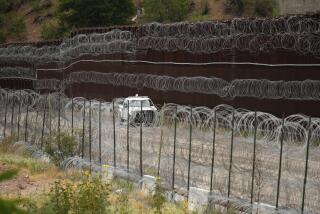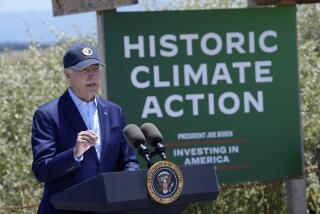U.S. suggests no emissions limits to protect polar bears
SEATTLE -- Polar bears are skating on thin ice in Alaska these days: Warming temperatures have resulted in dramatic shrinkage of sea ice, leaving the bears with fewer ice floes on which to rest and hunt seals.
But at least for the moment, the Endangered Species Act won’t be used to control the greenhouse gas emissions that conservationists say are contributing to climate change and posing one of the biggest threats to the bears’ survival.
The Obama administration on Tuesday released a proposed rule that -- like an earlier version put forward under President George W. Bush -- exempts operations outside the bears’ normal territory from restrictions on activities. That could include new coal-fired power plants or big factories with mercury emissions, which might harm bears thousands of miles away in the Arctic seas.
The rule, released by the U.S. Fish and Wildlife Service for public comment, was a setback for environmentalists who have argued it’s not enough to declare polar bears “threatened” under the Endangered Species Act without going after the industrial activities that may be contributing to the melting of sea ice.
“If polar bears are to survive, we have to directly confront the greatest threat to them: our greenhouse gas emissions. But the Obama administration seems to be living in a fantasy world where the way to solve a difficult problem is to deny its existence,” Kassie Siegel, director of the Center for Biological Diversity’s Climate Law Institute, said in a statement.
The oil and gas industry and manufacturing groups have vigorously argued just the opposite, saying it makes no sense to require someone building a bridge in Florida to compensate for threats to polar bears at the top of the globe.
“Otherwise, thousands of otherwise lawful activities outside the polar bear’s current range would be called into question and possibly generate lawsuits, unnecessary administrative actions and delays, and potential liability,” the National Assn. of Manufacturers said in an earlier statement.
The proposed new rule was issued after a federal judge ordered the government to provide additional environmental documentation for the original rule, handed down when polar bears were listed as threatened under the Endangered Species Act in 2008.
In the new environmental assessment, Fish and Wildlife managers argued that not issuing an exemption for harm to polar bears outside the Arctic would lead to a plethora of citizens’ lawsuits which, the agency said, had little chance of prevailing. Such suits would take up agency staffers’ time that could better be spent helping polar bears, they said.
Fish and Wildlife said the existing Marine Mammals Protection Act and the Convention on International Trade in Endangered Species of Wild Fauna and Flora provide plenty of protection for polar bears from oil and gas activities already occurring in polar bear habitat on Alaska’s North Slope, and those measures will be the guiding regulations in areas within polar bears’ current range.
Several conservation groups that originally challenged the exemptions are expected to use the upcoming public comment period to try to persuade Fish and Wildlife not to adopt the new rule.
Siegel said a better way would be to require greenhouse gas emitters to get permits from the federal government for projects that might affect polar bears, or risk citizens’ lawsuits if they don’t.
“The relevant question here is, what protections are necessary for the conservation of the polar bear,” she said in an interview. “At least now they’ve had to admit that there’s no conservation benefit to the polar bear from the exemption. They’re only doing it because they want to prevent citizens’ suits, which is undercutting Congress’ intent in putting the citizens’ suit provisions in to begin with, because [Congress] recognized that agencies often are unwilling or unable to bring enforcement actions.”
The Fish and Wildlife Service noted in its own press release on the rule that another section of the Endangered Species Act, Section 7, already requires federal agencies to ensure that actions they authorize do not harm threatened species or their habitat, and that requirement would not be changed.
So far, the Fish and Wildlife Service has not invoked that provision to control greenhouse gas emissions either. Conservationists have not ruled out filing a lawsuit to change that.
RELATED:
Polar bear’s long swim illustrates ice melt
Federal polar bear scientist back on the job
Polar bears and greenhouse gases: Can one live with the other?
More to Read
Sign up for Essential California
The most important California stories and recommendations in your inbox every morning.
You may occasionally receive promotional content from the Los Angeles Times.










